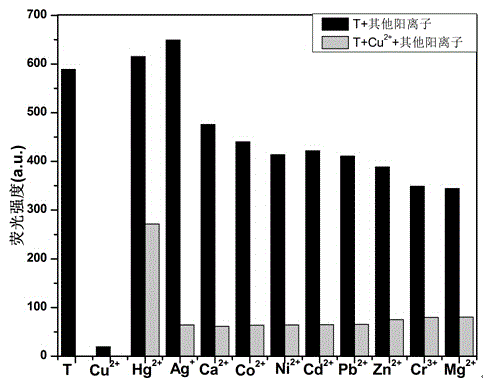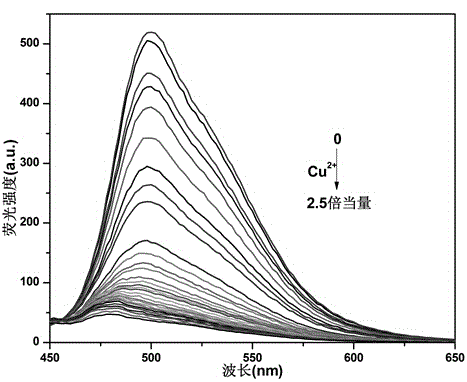Fluorescent recognition cupper ion (CU2+) sensor molecules and composition and application thereof
A fluorescence recognition and copper ion technology, applied in the field of cation detection and chemical synthesis, can solve the problem of fewer chemical sensors
- Summary
- Abstract
- Description
- Claims
- Application Information
AI Technical Summary
Problems solved by technology
Method used
Image
Examples
Embodiment Construction
[0035] The structure and synthesis of the sensor molecule of the present invention, the fluorescence recognition method for copper ions, the preparation and application of the detection test paper will be described in detail below through specific examples.
[0036] 1. Synthesis and characterization of sensor molecules
[0037] In a 250 mL round bottom flask, add 0.237 g (1.5 mmol) of naphthalene diamine, 0.770 g (4.0 mmol) of N,N-diethyl salicylaldehyde, 1 mL (0.017 mmol) of glacial acetic acid for catalyst, 30 mL of N,N- Dimethylimide (DMF) was used as a solvent, refluxed and stirred at 85°C for 8 hours, a yellow precipitate was precipitated, and the crude product was recrystallized with DMF to obtain a brownish-yellow crystal, which was the sensor molecule T. The yield: 83% (m.p. > 300°C). Its structure is characterized as follows:
[0038] 1 H NMR (DMSO– d 6 , 400 MHz) ? / ppm1.16 (t 12H,-CH 3 ), 3.41 (m 8H,-CH 2 -), 8.78 (s 1H, N CH),6.38-8.05 (m 12H, ArH),. IR (KBr)...
PUM
 Login to View More
Login to View More Abstract
Description
Claims
Application Information
 Login to View More
Login to View More - R&D
- Intellectual Property
- Life Sciences
- Materials
- Tech Scout
- Unparalleled Data Quality
- Higher Quality Content
- 60% Fewer Hallucinations
Browse by: Latest US Patents, China's latest patents, Technical Efficacy Thesaurus, Application Domain, Technology Topic, Popular Technical Reports.
© 2025 PatSnap. All rights reserved.Legal|Privacy policy|Modern Slavery Act Transparency Statement|Sitemap|About US| Contact US: help@patsnap.com



